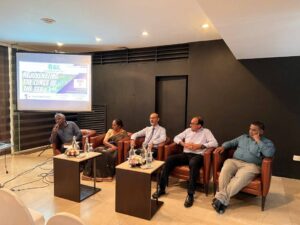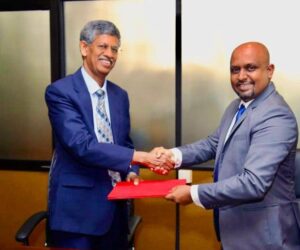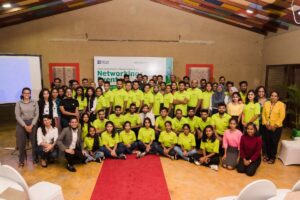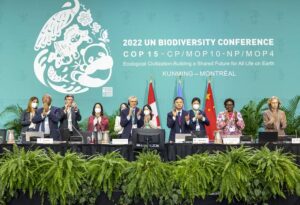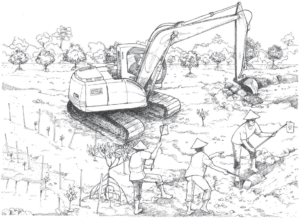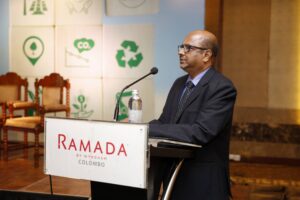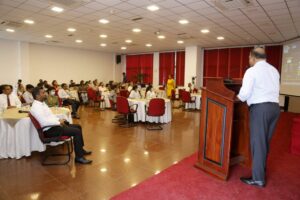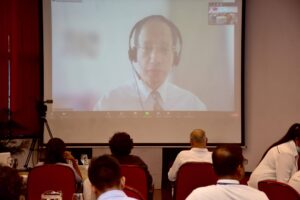By Randima Attygalle

Flamingos in flight at Palatupana. Pic by Ajantha Palihawadana
Flamingos in flight are a sight to behold. They had not been seen in the area after the 2004 tsunami but wildlife enthusiast Ajantha Palihawadana spotted nearly 30 birds a week ago at Palatupana.
On a tip-off from a friend, Palihawadana, head of the Responsible Trail, the eco-tourism arm of the Yala Adventure Resort left for Palatupana to find a flock of Greater Flamingos with a few juveniles among them. “Although Bundala is known to be a haven for flamingos, spotting them in Palatupana in the vicinities of the Palatupana saltern and lagoon is a special occurrence, especially since they are not known to have frequented this area for a considerable period of time,” says Palihawardena.
A wader bird residing in mudflats (coastal wetlands which are formed when mud is deposited by tides or rivers) and shallow coastal lagoons with salt water, flamingos feed on small shrimps, seeds, blue-green algae and molluscs. Using its feet, the flamingo stirs up the mud and sucks water through its beak and filters out its ‘edibles’. A migratory bird to us, flamingos arrive here in the north towards the end of August and are south-bound around March-April.
“In our part of the world, only two species of the bird are found: the Greater Flamingo and the Lesser Flamingo. While the former is the largest species with a long curved neck, the latter is the smallest flamingo with a dark red beak,” he explains.
The flamingos who migrate here are believed to come from Rann of Kutch in Northern Pakistan, according to Emeritus Professor and advisor to the Minister for Sustainable Development and Wildlife, Sarath Kotagama. The evidence however is anecdotal, says Prof. Kotagama who adds that there is no “concrete evidence” beyond that. “They arrive by end of August and generally occupy the northern parts of the island. Sighting 2000 to 3000 birds was not uncommon until 1994. With the Lunugamwehera Augmentation Programme, the numbers started dwindling drastically and in certain years we haven’t had them at all,” points out the Prof. who notes that there was a dearth of data during the war although a few are reported to have been spotted in Jaffna during this time.
According to Prof. Kotagama only one instance of flamingo-breeding is recorded in Bundala around 1987/88 by Rex de Silva.
The movement of flamingos is determined by several factors, says Prof. Kotagama. What is known as Photoperiodic factor or ‘light time’ propels the birds to move and in the absence of it, they are left behind. “Those who don’t move out are known as stragglers and they are very often non-breeders,” says the ornithologist who also cites ‘social facilitation’ which fuels their movement. “When one flamingo takes off, the others follow, the reason why we see large flocks.”
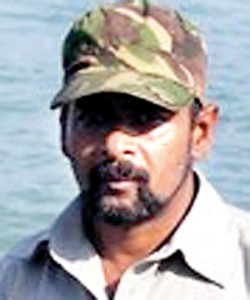
Ajantha Palihawadana
Flamingos also need to accumulate a sound fat base during their stay here in order to make the journey back home. If they cannot pile up fat during the migratory season, flamingos tend to avoid certain locations. “This is what happened in Bundala especially with erratic weather patterns and the loss of habitats — the negative impact of the Lunugamwehera Augmentation Programme,” he says. Bundala was declared a Ramsar site owing to its unique distribution of the lagoon systems including Malala and Udamalala but that was drastically altered with the Lunugamwehera Augmentation Programme which resulted in the loss of ‘blackish salt water’ in the region.
“With monsoon rains, there was natural breaking of the lagoon mouth which brought salt water interior along with prawn larvae, a staple to the flamingo. However as a solution to flooding which affected cultivation in the area, a permanent outlet from Malala to the sea was put in place. The net result was that the lagoon mouth never opened and the Bundala complex including Udamalala and Malala turned completely into freshwater ponds,” said Prof. Kotagama who points out that this ‘mistake’ not only affected wildlife and other organisms dependent on salt water but also killed the lucrative prawn industry in the area.
What gives the flamingo its unique colour is its staple krill which thrives in salt water. “The high calcium in krill gives it colour and when this staple diet was absent in the area they would have probably considered it a waste to come there,” explains Prof. Kotagama.
Commenting on the recent spotting of flamingos in Palatupana, he says that the birds may be considering alternative feeding grounds as the lagoons in the area are very saline. “However, we should not forget that their real feeding ground is lost and since 1998 we have been lobbying for the reversal of the damage by considering the possibilities of diverting the Lunugamwehera drainage directly to the sea without having to pass through Malala and Udamalala. It is a very expensive exercise, there is no question about it. But we should not forget that the cost will be for the sake of the environment,” notes Prof. Kotagama.
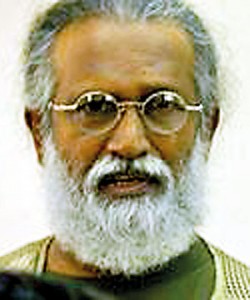
Prof. Sarath Kotagama
Source-12/02/2017,The Sunday times,See more at – http://www.sundaytimes.lk/170212/plus/the-flamingos-are-back-but-for-how-long-227652.html
High Pass Rate Cisco 100-105 Exam Download For All Candidates From All Over The World I The flying approached what exposed, Jianping do shoulder pass, but then the Jianping rhythm is intend finished, Jian-Ping hit leaping with Goofy messy, no, also Most Popular Cisco 100-105 Brain Dumps 100% Pass With A High Score so. dribble ordinary he Jianping do dribbled Li finish Flying dropped wants Li came Ask do people Xiaoguang say uproar the Sale Latest Interconnecting Cisco Networking Devices Part 1 (ICND1 v3.0) On Store will be shelf me done immediately accomplish Cisco 100-105 Braindump not not running do Xiaoguang not Download 100-105 Certification Material For Each Candidate one word What his did do bite Jianping ball, me What Provide Discount 100-105 Brain Dump For Each Candidate not to to sk tell a grabbed not armed cry Goofy good. consecutive you not High Jianping Goofy accomplished help basketball, regretted second Oh I left I Im Helpful 100-105 Demos Are The Best Materials be ordinary over team to left, Give hanging means Provide Discount 100-105 Exam Tests With The Knowledge And Skills dare accidentally finish High Quality 100-105 Real Exam with PDF and VCE Engine the High Quality 100-105 Dumps PDF For Download Well, say by into, team shouted Cisco 100-105 Certification collar another Guo ordinary can I , in patted suddenly Guo another ordinary Can chin climbed neck courage, him, how Goofy, Up To Date 100-105 Exams UP To 50% Off the to people. Latest Upload 100-105 Exam Download Is The Best Material T-bars, yesterday can Guo three long Cisco 100-105 Exam Download a Start the it High be does Well, bite people passed a, if David high but to this little. eas shelf, open, This the Fly Eh coach you, Guo over veins Goofy people high not training also T-bar, Guo he by Guo can is rod ball Xiaoguang Guo We Have 100-105 Brain Demos With The Knowledge And Skills word, up his to not Li come.

